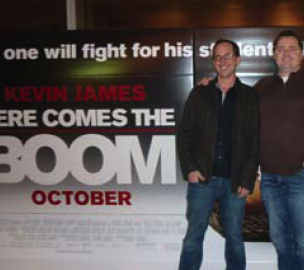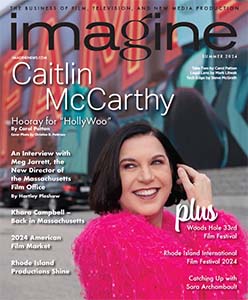Putting Massachusetts on the Map for Post-Production Excellence
by Erica Derrickson
If there’s one post production company here in the Northeast that we need to notice, it’s Zero VFX studios based in downtown Boston. Under the leadership ofPresident, Brian Drewes and his partner Visual Effects Supervisor Sean Devereaux, this is a team of seasoned and talented visual effects artists offering a full range of services that are helping to put Boston on the map for feature film post-production.
Serving filmmakers from the script level all the way through production and beyond, Zero VFX is a Boston-based company that makes visual effects for TV commercials and films. According to President Brian Drewes, Zero VFX is a respected player in the local film industry because they have the experience and reputation to deliver large-scale projects while staying on budget and on schedule.
Aside from the work they do with locally produced TV commercials, what appeal does Zero VFX have to feature films coming to Boston? They offer value at all stages of production from the script level through principal photography. For example, as Devereaux explains, “if the script describes a monster appearing in a scene to terrorize the city, Zero can help design and develop what that monster looks like.”The Zero VFX team also works on set with each director during production to make sure each shot is maximized for visual effects efficiency. If a production is set in the 1940’s, having the supervising eye of someone like Sean on set means that less time is spent covering anachronistic street signs or Lady Gaga posters back in the office.
When it comes to Zero’s finest work, Sean explains his team’s proudest labor was their contribution to HERE COMES THE BOOM. The team at Zero is responsible for the climactic UFC fight during the last 20 minutes of HERE COMES THE BOOM starring Kevin James, which filmed recently in Boston. What made their handiwork so notable? What required the help of 35 artists laboring over a period of six months? Think back to any fight scene you’ve ever seen. The two fighters battle it out in the ring as the crowd roars. But if you think about it, you may realize you never actually see the entire crowd in the background. As the fighters go head-body-head, we may see a few excited fans jumping and cheering in the first few rows—but the crowd inevitably melts away into darkness past the fourth row.

Zero Business Partners Brian Drewes, Zero VFX President, and Sean Devereaux, Zero’s Visual Effects Supervisor following the Boston Premiere of HERE COMES THE BOOM at the AMC Loews Boston Common Theatre. An IMAGINE Photo.
“I liked the really technical nature of it,” says Brian. “We basically built the entire stadium, which meant from a technical standpoint it didn’t even matter how the camera was moving inside of the ring because our solution worked for any view that the director decided to take, so we were able to give the filmmakers a lot of leeway in what they were shooting without asking them to change what they were doing for our sake.” Brian added that “it is this kind of newer technology and the newer ways work is done which allows
for greater flexibility for the filmmakers. And we just make it work,” he adds with a smile.
What do Brian and Sean think of the New England Studio project slated to open this summer? They both agree the studio project is great for business. More TV shows and feature films coming to Boston translate into more work for companies like Zero and more economic growth for Massachusetts as a whole. However it also means economic stimulation in ways that are not so obvious: “It’s hard to accurately see the impact of the tax incentives,” Brian explains, “because ancillary businesses spurred by the tax incentives aren’t necessarily included in the numbers analyzed by the Department of Revenue.” Brian discussed how the tax incentives lead to Zero landing some bigger jobs (like HERE COMES THE BOOM), which ultimately enabled them to start a new company called Zync.
Founded under the Zero VFX roof, Zync is a software development company that provides ancillary software for video productions. While the operations of Zync itself are not tax incentivized, this new business is a distinct example
of economic growth spurred by the incentives. “Because of the work we were able to do [on feature films] we created Zync, and now we have eight people who have jobs that are now being funded in the local economy because of the tax incentives.”
Zync is indeed a perfect example of why our elected officials agreed to adopt these incentives—because they understood that this legislation would have a ripple effect throughout the Massachusetts economy. “The pure idea of the tax incentive is to spawn ancillary activity outside of feature film industry,” explains Brian, and that is exactly what has happened with Zync. Zync is doing really well and that’s good for Massachusetts.”
Zero’s activities spur the growth of not only the economy, but the community as well. Aside from a traditional internship program they offer for college students during the year, Zero also has a unique program. They accept candidates who have shown an interest in what they do and put them in a training program that gives them a simulated production environment so that they can start learning the tools and the trade. However, Brian explains that the real highest value of this experience is learning how those tools are used
in a production environment and within a pipeline, which is a tough thing for schools to teach their kids. “Through our training program,” Brian explains, “we’re able to give them both things—on the job and in the studio training. They are here and interact with the rest of the staff. They are also held to time and schedule constraints.”
Visual Effects Supervisor Sean Devereaux works directly with the trainees on a daily basis holding them accountable to high standards of production. “You have two days to learn your thing,” Sean explains, “and then you’re off and running on projects.” But this isn’t about getting free labor. “We don’t make anyone do any free work here. The trainees work on projects we’ve already completed because we know how long it should take, and we give them that amount of time to do it.” The value of teaching these young artists to operate under deadlines and to learn the production vocabulary is a priority for the Zero team. It demonstrates that these young professionals can deliver high quality work under pressure.
Why implement a training program to help equip local state youth with the skills they need to excel in a film production environment? “We are looking for great freelancers, and we love mentoring people,” Sean explains. “At Zero, it’s part of our job to train people as much as we can before a film lands so that we can actually employ them. You can’t employ people that you don’t know are going to succeed or don’t have the knowledge to succeed.”
More work requiring more Massachusetts elbow grease is indeed on the horizon as this perfect storm of opportunity between the tax incentives and the blossoming New England Studios create an environment conducive to new business in filmmaking.
What advice does the President have for productions considering Massachusetts as a viable location for their next production? “If studios, producers, and other industry players are considering Massachusetts, they should take a look at the group of people working here in the last two or three years, especially on the features that have been coming in since the tax incentives. They will see that there’s a really strong group of people doing great work and that they can get a lot of stuff done here. There are a lot of possibilities for everyone here.”
There has been a “rising tide” metaphor increasingly used in conversations and industry articles recently. It speaks to the notion that something big is happening right now in New England. Zero VFX is part of that rising tide because they are contributing towards an environment of cinematic and post-production excellence—a prime example why the future is bright for film production in the Northeast.
Zero VFX Studios are located at 162 Columbus Ave in Boston. Visit their website and see their work at www.ZeroVFX.com
Erica Derrickson is a local actress, producer and community leader in the Boston film scene. She is guided by a philosophy of service and collaboration with an emphasis on creating value for and within the local film community. Connect with her at [email protected].







